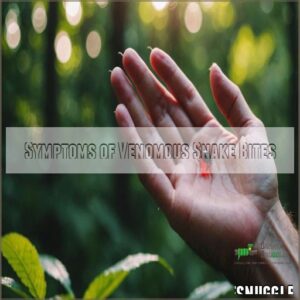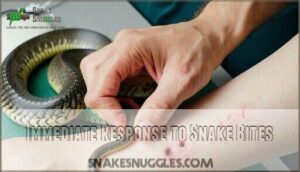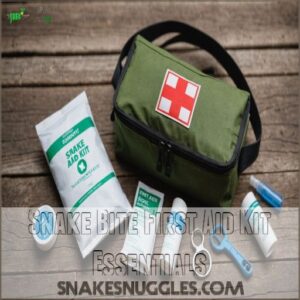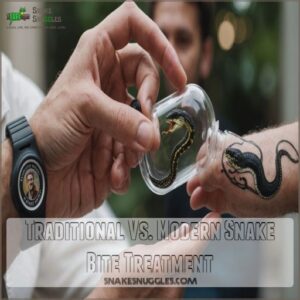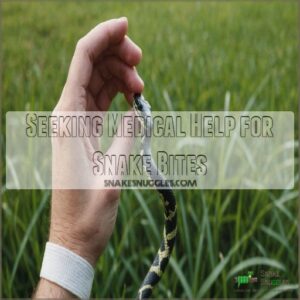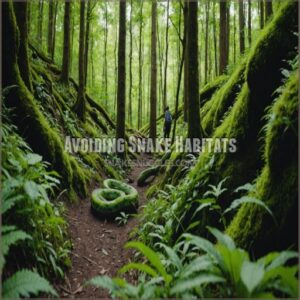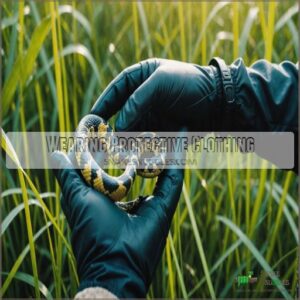This site is supported by our readers. We may earn a commission, at no cost to you, if you purchase through links.
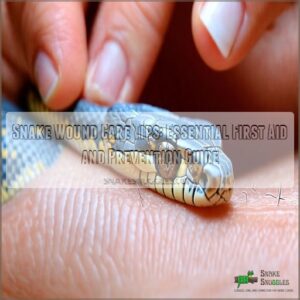
First, stay calm and back away from the snake—no need for a hero moment here!
Remove any rings or watches before swelling sets in.
Clean the wound gently with soap and water, then loosely cover it with a clean bandage.
Avoid the temptation to go full cowboy by sucking out venom or using ice.
Instead, keep the affected area still and wait for medical help.
Curious about how to make your own snakebite first aid kit or the surprising benefits of modern treatment?
Stick around for more insights!
Table Of Contents
- Key Takeaways
- Identifying Venomous Snakes
- Symptoms of Venomous Snake Bites
- Immediate Response to Snake Bites
- Wound Care for Snake Bites
- Common Mistakes in Snake Bite Treatment
- Snake Bite First Aid Kit Essentials
- Traditional Vs. Modern Snake Bite Treatment
- Seeking Medical Help for Snake Bites
- Preventing Snake Bites
- Snake Bite Statistics and Awareness
- Frequently Asked Questions (FAQs)
- How to care for a snake bite?
- What is the recommended line of management for rattle snake bite in humans?
- How do you treat a venomous snake?
- How do you handle a snake?
- What can I put on my snakes wound?
- How long can snakes heal from wounds?
- How to treat a wounded snake?
- How to bandage a wounded snake?
- Can snake venom cause allergic reactions?
- How long does snake venom stay potent?
- What are snake bite antivenom side effects?
- Do all snakes strike humans unprovoked?
- Are snake bites more common in certain seasons?
- Conclusion
Key Takeaways
- Stay calm and move away from the snake to prioritize safety and prevent further injury.
- Gently clean the wound with soap and water, then loosely bandage it to avoid infection.
- Don’t attempt to suck out venom or use ice; instead, keep the affected area still until medical help arrives.
- Remove jewelry and tight clothing to prevent complications from swelling.
Identifying Venomous Snakes
When you’re hiking or exploring, recognizing key characteristics like triangular-shaped heads and vertical pupils in snakes can help you identify potential threats. Knowing how to identify venomous snakes can be a lifesaver—literally!
Knowing how to identify venomous snakes can be a lifesaver—literally!
Look for signs like a triangular head, slit-like eyes, and the signature fangs that set them apart from their nonvenomous cousins.
Physical Characteristics of Venomous Snakes
Spotting venomous snakes hinges on key traits that shout danger.
Look for the triangle-shaped head that’s a dead giveaway.
Those slit-like pupils? Like they just had a bad day.
Body patterns often mimic camouflage but pack a punch with hidden venomous fangs.
Also, consider their geographic distribution; certain snakes are all about local flavor!
Stay alert for safe snake wound care.
Common Types of Venomous Snakes
Someone once told me, "Knowing your enemy is half the battle."
That’s especially true with venomous snakes.
You’ll want to familiarize yourself with common culprits like rattlesnakes, with their distinctive rattles, and copperheads, known for their hourglass markings.
Coral snakes, with their bright bands, are another dangerous group.
Learning to identify these venomous snakes is key for snakebite prevention.
Remember, quick identification is vital for effective snakebite first aid.
Geographic Distribution of Venomous Snakes
Rattlesnakes, copperheads, and coral snakes aren’t just fascinating; their geographic spread is essential info if you’re keen on avoiding unexpected bites.
Understanding venomous snake hotspots helps with preparation.
Here’s a quick rundown:
- North America: Rattlesnakes rule.
- Australia: Taipans strike fear.
- Asia: Cobras and vipers abound.
- Africa: Mambas menace.
Stay informed with snake distribution maps!
Symptoms of Venomous Snake Bites
When you’re bitten by a venomous snake, you’ll likely experience symptoms like swelling and severe pain at the site.
You should get concerned if you’re starting to feel odd things like tingling or a metallic taste.
Localized Symptoms
When a venomous snake sinks its fangs into you, expect instant pain.
You might notice swelling, redness, and discoloration creeping from the bite site as cytotoxins and haemorrhagins do their nasty work.
It’s important to have a snake bite kit on hand, which can be purchased online from a snake bite kit supplier.
Bruising adds colorful proof of envenoming.
It’s important to watch these snake bite symptoms closely to manage and treat them effectively, ensuring your safety and well-being.
Systemic Symptoms
Imagine feeling nausea and extreme weakness creeping in.
These systemic symptoms of snake poisoning might also include breathing difficulties and swelling.
Snake toxins can wreak havoc on your body, so knowing the stats and having antivenom drugs handy is smart.
Remember, pain isn’t the only indicator.
Watch for these symptoms, and seek help immediately for a safe, controlled recovery.
Neurotoxic Symptoms
Eye muscles drooping and trouble swallowing? You’re dealing with neurotoxic symptoms from venomous bites, particularly those from elapids like cobras.
Rattlesnake venom can also cause neurotoxic effects like muscle weakness and paralysis, and prompt administration of antivenom is essential to neutralize these effects, as explained in more about rattlesnake venom neurotoxic effects.
If you experience these, it’s a snake bite emergency. Think "act fast" by seeking medical help immediately.
Knowing neurotoxin types and treatment options can save your skin.
Prevention tips? Always be snake-smart in their habitats to minimize encounters.
Immediate Response to Snake Bites
When you find yourself face-to-fang with a snake bite, staying calm is your first critical move.
Remove any constrictive items and keep the bitten area as still as possible to manage swelling.
Staying Calm and Moving Away
Facing a snakebite? Deep breaths! Panic attacks won’t help.
First, calmly move away from the snake.
Observe its appearance; a photo helps first responders.
Knowing the timeline of snake bite symptoms, including recognizing snake bite symptoms, is key for snake bite management and snake behavior.
Remember, snake bite severity varies; quick action improves snake bite survival.
Don’t let snake bite myths cloud your judgment.
Getting help is your best defense against snake bite misconceptions.
Removing Constrictive Items
After calmly moving away from danger, don’t forget to act swiftly.
Remove constrictive items like jewelry and tight bands—they’re not fashion accessories for snake bites! Quick reflexes can help prevent swelling.
Check for:
- Watches wrist wraps
- Rings clinging to fingers
- Clothing that fits snugly
- Tight Bands squeezing limbs
- Anything hindering snake bite aftercare
Your snake bite care matters!
Keeping The Bitten Area Still
Once you’ve removed anything tight, focus on keeping the bitten area still to reduce venom spread.
Immobilization with splints can be handy.
It mightn’t be thrilling, but staying put saves pain.
While waiting for medical transport, remember: rattlesnake bites, vipers, and other snake bites require calm, not chaos.
| Action | Why | How to Implement |
|---|---|---|
| Immobilization | Reduces venom spread | Use splints |
| Remain Calm | Aids in pain management | Deep breaths |
| Wait for Medical Transport | Provides expert care | Call emergency services |
Wound Care for Snake Bites
If you’re ever bitten by a snake, it’s essential to clean the wound quickly and thoroughly.
Applying gentle pressure and elevating the affected limb helps manage swelling and reduce pain, making you feel like a superhero under pressure.
Cleaning The Wound
Cleaning the wound is your next step in snake bite care. Gently run water over the wound for effective wound irrigation, using mild soap if available. An antiseptic can be helpful, but try soap alternatives if it’s handy.
Remember, maintaining snake safety by avoiding risky areas can prevent these bites.
- Use clean, fresh water.
- Avoid unnecessary scrubbing.
- Discard used materials safely.
Applying Gentle Pressure
Gently applying pressure helps control bleeding from snake bites, like those from pit vipers or copperheads.
Use a clean cloth or bandage to compress the wound site—not too tight or loose.
Think of it as a gentle yet firm handshake with the bite area.
This helps manage bleeding without worsening the effects of myotoxins or anti-clotting agents.
Elevating The Affected Limb
Did you know elevating the bitten limb can reduce swelling and help with lymphatic drainage?
By positioning the limb slightly above heart level, you harness gravity’s effect to better manage blood flow.
Whether it’s a coral snake bite or just a pesky scratch from a nonvenomous snake, this simple shift works wonders.
Always remember, quick action counts!
Common Mistakes in Snake Bite Treatment
Let’s face it, snake bites are scary, and it’s easy to make mistakes when you’re panicked.
This section will cover common errors in snake bite treatment, so you can avoid them and get the best possible care.
Applying a Tourniquet
Regarding snakebite treatment, don’t rush to use that tourniquet.
Despite popular belief, tourniquet effectiveness in this situation is minimal and risks outweigh benefits.
You’re better off exploring tourniquet alternatives like keeping calm and immobilizing the limb.
Timing is critical, but a tourniquet can do more harm than good.
Remember, first-aid measures matter!
Sucking Out The Venom
Sucking out the venom from a snakebite might sound like a quick fix, but it’s a myth rooted more in Hollywood than reality.
This outdated method isn’t effective and can actually cause harm.
Instead, focus on modern alternatives that prioritize safety and effectiveness.
Remember, it’s about understanding the safety concerns and leaving historical practices where they belong—in the past.
Using Ice or Cold Packs
While trying to suck out venom seems tempting, reaching for an ice pack sounds logical too.
Spoiler alert: it’s not.
In fact, exposing snakes to cold temperatures can be detrimental to their health, as it can lead to cold stress in snakes.
Ice packs might seem like a smart move for swelling management, but they can worsen damage.
Instead, focus on keeping the wound clean and stable.
Save the cold therapy for sore muscles, not snake bites.
Stay safe!
Snake Bite First Aid Kit Essentials
When you’re preparing a first aid kit for snake bites, it’s crucial to remember that applying a tourniquet is risky and can worsen swelling or infection, as discussed in snake wound care at home. Including essentials like bandages, wound cleaning agents, and immobilization devices is very important.
Antivenom and pain relievers can save you some major headaches—literally and figuratively!
Bandages and Wound Cleaning Agents
Don’t brush off the importance of proper bandages and wound cleaning agents in your snake bite first aid kit. Here’s what you need:
- Types of Bandages: Use clean, breathable bandages to cover the wound.
- Cleaning Solutions: Clean the bite with mild soap and water for infection prevention.
- Wound Care: Keep the wound loosely covered to aid healing.
Antivenom and Pain Relievers
In the heat of the moment, having antivenom at the ready is essential.
Recognize its effectiveness but be aware of potential side effects.
Pair it with pain relief options like acetaminophen to help manage discomfort.
When dealing with snake bites, it’s crucial to follow proper first aid techniques, such as keeping the affected area below heart level and seeking immediate medical attention by calling 9-1-1. Consider varied pain management strategies to tackle pain effectively, ensuring your snake bite kit is well-stocked for any situation you encounter.
Immobilization Devices
Someone needs to keep that bitten area still, right? Immobilization devices are key! You can find these essential items and more in a basic first aid kit online.
You’ll want to include these in your snake bite first aid kit:
- Rigid splints: These provide excellent support.
- Triangular bandages: Great for slings or makeshift splints.
- A small, lightweight backboard: Perfect for transporting someone safely. Remember, keeping the affected area still is very important.
Traditional Vs. Modern Snake Bite Treatment
Deciding between traditional and modern snake bite treatments can feel like choosing between grandma’s remedies and a high-tech wizard. When it comes to snake bite first aid, following steps like snake bite first aid can make all the difference in emergency situations.
You’ll learn how folk methods stack up against today’s medical advancements, and what’s really worth your time when snake fangs make an unwelcome appearance.
Effectiveness of Traditional Methods
You might wonder if traditional methods stack up against modern medicine.
Cultural beliefs have led to fascinating historical practices, but their effectiveness varies.
Modern studies suggest that these approaches often lag behind advanced medical treatments.
Here’s a quick comparison:
| Traditional Methods | Modern Medicine |
|---|---|
| Folk Remedies | Antivenom |
| Herbal Poultices | Pain Management |
| Rituals | Clinical Care |
| Anecdotal Evidence | Research-Based |
Risks and Complications of Traditional Methods
Traditional snakebite treatments often miss the mark, sometimes leading to infection risk or tissue damage.
Ever try removing venom with a knife? That’s a one-way ticket to more harm and potential scarring.
Delayed treatment can allow venom to spread, worsening your predicament.
Stick to proven methods, because, honestly, no one wants a DIY venom-removal horror story.
Benefits of Modern Medical Treatment
While traditional remedies often lack consistency and can be risky, modern medical treatments shine like a lighthouse guiding us to safety.
With antivenom availability and advanced therapies, such as devices utilizing snake venom pump mechanisms, you’ll benefit from faster recovery, reduced mortality, and improved diagnosis.
Hospitals deliver these treatments efficiently, making snakebite care as reliable as a morning coffee brew.
Why settle for outdated methods?
Seeking Medical Help for Snake Bites
If you encounter a snake and it feels threatened or territorial, it may use camouflage, hissing, and quick strikes as defensive mechanisms, understanding snake behavior. If you suspect a venomous snake bite, don’t hesitate to seek immediate medical attention.
At the hospital, doctors will assess your condition, provide antivenom if necessary, and guide you through follow-up care.
When to Seek Immediate Medical Attention
Imagine this: in areas with tall grass and brush, a child may unknowingly encounter a snake, and if bitten, it’s crucial to know snake bite prevention. a child with a snake bite showing snake bite symptoms like rapid swelling or difficulty breathing.
If you suspect a venomous snakebite, such as from a rattlesnake or copperhead, it’s critical to recognize the symptoms early.
That’s when you need to drop everything and head to the hospital.
Bite severity can escalate quickly, so seeking immediate medical help is essential.
Don’t wait around; it’s better to be safe than sorry when snakes are involved!
What to Expect at The Hospital
At the hospital, expect a thorough examination.
Doctors will identify the snake if possible.
They’ll monitor your health indicators and manage your pain.
Antivenom administration might be necessary, depending on the severity.
Hospital procedures vary, but you’ll receive patient education and a recovery timeline.
Remember, staying calm helps.
It’s all part of the process.
Follow-up Care and Rehabilitation
After hospital care, grasp the importance of follow-up care and rehabilitation.
It helps manage long-term effects and scarring.
Remember these steps:
- Physical therapy can help restore mobility.
- Medication management makes sure proper healing takes place.
- Address the psychological impact—don’t underestimate it.
- Regular check-ups monitor recovery and tackle stress.
These steps can be your safety net to recovery.
Preventing Snake Bites
You can dodge snake bites with a few simple precautions, like staying clear of their habitats and wearing protective clothing.
Keeping an eye on your surroundings is as important as spotting a trail of ants heading to your picnic.
Avoiding Snake Habitats
While wandering through untamed landscapes or just enjoying your garden, steer clear of overgrown grass, piles of wood, or rock crevices where snakes love to hide.
Hiking safety starts with your route, so choose paths wisely.
Keep your campsite tidy and free of accidental snake shelters.
A touch of wildlife awareness keeps you and your fellow outdoor enthusiasts happily bite-free.
Wearing Protective Clothing
Staying safe in snake habitats means gearing up smartly.
Why risk it when you can suit up?
Try these:
- Snake-proof boots for trekking in venomous snake regions.
- Hiking attire as your first line of defense.
- Workwear safety in snake-prone jobs.
- Garden gloves during backyard ventures.
These choices might just keep you a step ahead!
Being Aware of One’s Surroundings
Imagine this: you’re enjoying a peaceful hike, but suddenly there’s a rustle in the bushes.
To reduce the risk of a snake encounter, it’s important to understand snake habitats, as they often prefer quiet, cool spots like woodpiles or tall grass.
Stick to clear paths, keep an eye out for movement, and tap the ground with your walking stick.
It’s all about minimizing risks and staying safe in snake habitats, especially during peak seasons.
Snake Bite Statistics and Awareness
You might be surprised to learn that snake bites affect millions globally each year, causing thousands of deaths.
Awareness and education are key to avoiding these encounters and ensuring your safety.
Global Snake Bite Statistics
So, you’ve learned how to avoid snake bites. Good job!
Now, let’s talk numbers. Globally, millions suffer snakebites yearly. Sadly, tens of thousands die.
These snake bite trends highlight the need for better treatment access and prevention efforts. The impact on communities is huge.
Understanding these statistics empowers you to make informed choices and support relevant initiatives. It’s a scary thought, but knowledge is power, right?
Regional Variations in Snake Bite Incidence
Different regions show varying snake bite rates due to climate, habitat, and population density, where understanding venomous snake characteristics can help identify potential threats, with only about 20% of snake species being venomous in these areas.
For instance, you might find:
- Tropical areas with diverse snake species and high incidences.
- Desert habitats where bites are fewer but potentially dangerous.
- Urban regions with lower rates but challenges in quick medical access, where knowing venomous snake bite symptoms is essential.
Importance of Public Awareness and Education
Understanding regional snake bite variations can lead you to appreciate education and public awareness.
Here’s the scoop: communities need myth-busting, first aid training, and preventive tips connecting everyone like a well-tuned orchestra.
Spark curiosity with educational resources and community outreach.
| Topic | Action Step | Outcome |
|---|---|---|
| Myth Busting | Host workshops | Dispels false beliefs |
| First Aid Training | Schools & groups | Enhances safety |
| Educational Tools | Distribute guides | Increases awareness |
| Community Outreach | Engage with locals | Builds trust |
| Prevention Tips | Regular updates | Informs & protects |
Frequently Asked Questions (FAQs)
How to care for a snake bite?
Snake bites can be tricky.
First, stay calm, move away from the snake, and call emergency services.
Clean the wound gently with soap and water.
Avoid tight clothes or jewelry, and don’t suck out venom.
What is the recommended line of management for rattle snake bite in humans?
If a rattlesnake bites you, quickly call for medical help.
Stay calm, move away from the snake, and keep the bite below heart level.
Avoid tight clothing, jewelry, or common myths like sucking the venom out.
How do you treat a venomous snake?
You don’t treat a venomous snake; you seek immediate medical help! Don’t try to catch it; stay calm, and get to a hospital ASAP. Remember, your safety’s key.
How do you handle a snake?
There are over 3,000 snake species worldwide, and handling them safely requires care.
First, observe from a safe distance.
Never approach unfamiliar snakes.
Use a snake hook to gently lift if necessary, and always seek professional guidance.
What can I put on my snakes wound?
Start with gently cleaning your snake’s wound using mild soap and water.
Apply an antiseptic ointment, like povidone-iodine, to prevent infection.
Avoid using harsh chemicals, and monitor the wound closely as it heals.
Seek vet advice if needed.
How long can snakes heal from wounds?
Expect a snake’s healing process to rival that of a slow-moving sloth.
Snakes typically heal in a few weeks, depending on the wound’s severity.
Keep the environment clean to speed up recovery and reduce stress.
How to treat a wounded snake?
Gently clean the snake’s wound with diluted antiseptic, avoiding harsh chemicals.
Keep it in a quiet, sterile area.
Consult a vet for a professional assessment, as improper care can worsen injuries.
Avoid home remedies or DIY fixes.
How to bandage a wounded snake?
Bandage a snake by securing soft, non-stick gauze over the wound.
Snugly wrap with self-adhesive bandage, ensuring not to restrict movement or circulation.
This protects the injury, similar to how we might shield a scraped knee.
Can snake venom cause allergic reactions?
Snake venom can indeed trigger allergic reactions in some people.
If you experience symptoms like difficulty breathing, swelling, or hives after a bite, seek immediate medical attention.
Reactions vary, so staying alert is essential for safety.
How long does snake venom stay potent?
Think of venom’s potency like a wilting flower; it degrades over time.
It’s highly variable depending on the species and conditions, but generally loses strength within hours or days.
Don’t delay seeking medical help!
What are snake bite antivenom side effects?
Antivenom side effects can include allergic reactions like rash, itching, or swelling, and more severe responses such as fever, vomiting, or breathing difficulties.
Always inform your doctor about any allergies to guarantee safe and effective treatment.
Do all snakes strike humans unprovoked?
Snakes, like the shy kid at a party, usually don’t strike unless provoked.
Most prefer avoiding humans.
However, if they feel threatened, they’re more likely to defend themselves.
So, give them space and stay alert.
Are snake bites more common in certain seasons?
Snake bites tend to be more common in warmer months, like spring and summer, when snakes are more active and people spend more time outdoors.
This increases the likelihood of accidental encounters with these slithery critters.
Conclusion
Afraid of snakes? Don’t worry, we’ve all been there.
With these essential snake wound care tips, you’re prepared for any unexpected encounter.
Remember, staying calm is key.
Cleaning the wound gently and immobilizing the area can make a big difference.
Avoid common mistakes like sucking out venom or using ice.
A well-equipped snakebite first aid kit can be a lifesaver.
Stay informed, take precautions, and you’ll reduce your risk of snake bites considerably.
- https://www.mayoclinic.org/first-aid/first-aid-snake-bites/basics/art-20056681
- https://www.darwynhealth.com/injuries-and-poisoning/poisoning/bites-and-stings/snakebites/first-aid-for-snakebites-what-to-do-and-what-not-to-do/?lang=en
- https://my.clevelandclinic.org/health/diseases/15647-snake-bites?management-and-treatment


